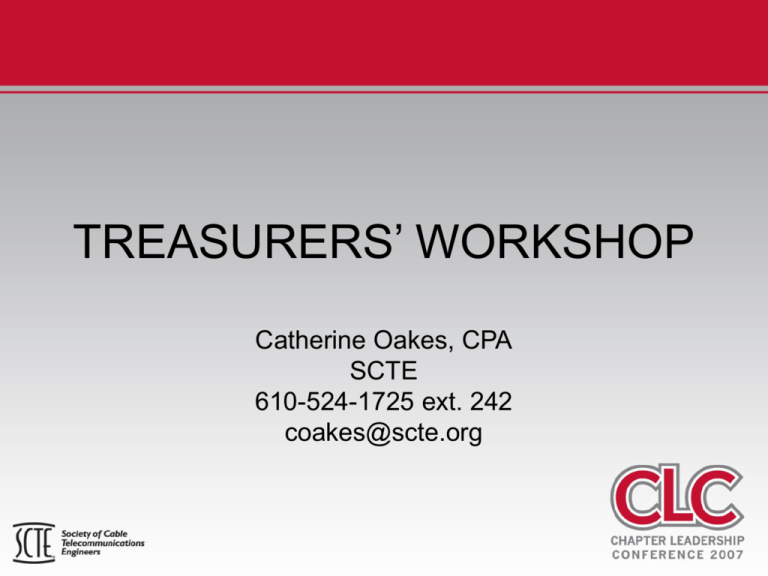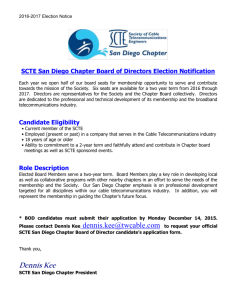Sarbanes-Oxley Act
advertisement

TREASURERS’ WORKSHOP Catherine Oakes, CPA SCTE 610-524-1725 ext. 242 coakes@scte.org Table of Contents I. II. History of SCTE Nonprofit vs. Business A. Tax-exempt Status B. Contributions C. Operating Purpose D. Ownership E. Unique Financial Reporting Objective F. Unique Accounting & Reporting Practices 1) 2) 3) III. GAAP Sarbanes Oxley Form 990/990-T Accounting for Chapters The History of SCTE • 1969 – 65 engineers formed the organization – our Charter Members • 1975 – Society of Cable Television Engineers incorporated in New Jersey and applied for taxexempt status under Internal Revenue Code Section 501(c)(6). • 1995 – Changed name to Society of Cable Telecommunication Engineers, Inc. • Today – serves nearly 15,000 members from the National Office in Exton, PA and has 68 Chapters throughout the nation. A Nonprofit’s Place in Economy Three principal sectors of the Economy: 1. Government 2. Business 3. The Nonprofit Nonprofit vs. Business The Key Differences between Nonprofit Organizations and Businesses: 1. 2. 3. 4. 5. 6. Tax-exempt Status Contributions/Donations Operating Purpose Absence of Commercial Ownership Unique Financial Reporting Objectives Unique Accounting & Reporting Practices Tax-exempt Status The role of the Internal Revenue Service with regard to the nonprofit organization is: 1. Granting the exemption to pay federal income taxes under IRC 501(c) – 25 different types of nonprofit organizations. 2. Enforcement – policing the conditions underlying the favored-status treatment. SCTE tax-exempt under 501(c)(6) Code Section 501(c)(6) provides for the exemption of Business Leagues if: 1. They are not organized for profit 2. No part of their net earnings inure to the benefit of any shareholder or individual. IRC Section 501(c)(6) 501(c)(6) provides an exemption for Business Leagues. Definition – A Business League is an association of persons having some common business interest, the purpose of which is to promote such common interest and not to engage in a regular business of a kind ordinarily carried on for profit. 501(c)(6) Requirements • • • • Common Business Interest Primary Purpose is to Promote Exempt Purpose Not Organized for Profit No Part of Earnings Inure to the Benefit of any individual. • Membership Organization that benefits the industry and is supported by membership dues. **EXEMPTION CAN BE REVOKED IF FAIL TO MEET REQUIREMENTS** Chapters Exempt Status Group Exemption issued to SCTE to include Chapters as exempt under SCTE. • SCTE Employer Identification Number covers all Chapters. • Chapters Financial information consolidated with SCTE in Audit Report and IRS Form 990. • Chapters should use SCTE’s full name when issuing Form W-9 to vendors. Other Tax Issues SCTE and Chapters not exempt for: • Sales Tax • Employer Tax • Unrelated Business Income Contributions Nonprofit vs. Business – Businesses normally don’t receive contributions or donations. • SCTE and Chapters MUST disclose that contributions are not tax deductible. Failure to make disclosure will result in an IRS fine of $1,000 per day, up to $10,000 per year. “Contributions or gifts to The Society of Cable Telecommunication Engineers, Inc. are not deductible as charitable contributions for Federal Income Tax Purposes” Operating Purpose Business mission is to make a profit. Nonprofit (business league) mission is to improve business conditions in one or more “lines of business” within an industry. “SCTE is organized to develop, increase and spread both theoretical and practical technical knowledge of cable telecommunications and broadband communications systems thereby providing opportunities for the professional and technical growth of its membership and the industry.” Purpose Primary purpose is to promote tax exempt mission. ACTIVITIES must promote improvement to Cable Telecommunications Engineering Industry. Secondary purpose can be to generate profit. Accounting & Reporting Practices Financial Accounting Standards Board (FASB) and American Institute of Certified Public Accountants (AICPA) develop GAAP – Generally Accepted Accounting Principles – Accrual Basis of Accounting – Specific Financial Statement Formats for Not-for-profit Organizations. Sarbanes-Oxley Act – Whistleblower Protection – Destruction of documents to thwart federal government investigation. Form 990 & 990-T – Unrelated Business Income SARBANES-OXLEY ACT • • • • • • • • Audit Committee Auditor independence Conflict of Interest Policy Insider Transactions (Loans to Executive Officers & Board Members) Certified Financial Statements Financial Disclosure Whistle-Blower Protection Internal Controls- (Document Retention Policy) FORM 990 and FORM 990-T • Form 990, Return of Organization Exempt from Income Tax–Due May 15th each year. • Must be available for public inspection upon request. • Form 990-T, Unrelated Business Income Tax Return. • Tax paid on Unrelated Business Income (“UBI”) Unrelated Business Income • Revenue that does not promote exempt purpose. • SCTE currently pays UBI tax on income from Advertising and some Merchandise sales. • Need to properly track expenses related to UBI. • Chapters cannot accept advertising. Accounting for Chapters Bank Accounts • Bank Accounts Use SCTE EIN, no personal info of anyone. Reconcile (adjust) the bank balance to match your register balance. Reconcile as of the last day of the month. Provide documentation when submitting reconciliation to Exton office (copy of bank statement, reconciliation, list of outstanding checks). Accounting for Chapters Quarterly Financial Reports • Confirm achievement of SCTE’s exempt purpose. • Avoid over use of Miscellaneous Income/Expense Account. Please be descript. • Due to Exton office 30 days after close of quarter. • Auditors select Chapters to Audit in detail. Chapter Accounting Timeline • Jan. 31st – Bank Reconciliation and 4th quarter report due. • Mid-February – Audit begins • Mid-April – Audit concludes • April 30th – bank rec. and 1st quarter report due. • May 15th – Forms 990 & 990-T due. • July 31st – bank rec. and 2nd quarter report due. • Oct. 31st – bank rec. and 3rd quarter report due. Insurance • Vendor Days – AON Assn Services Div. 800-424-8830 – Revenue based, $500 minimum premium – Obtain certificates of insurance from exhibitors, $1,000,000 per occurrence.





